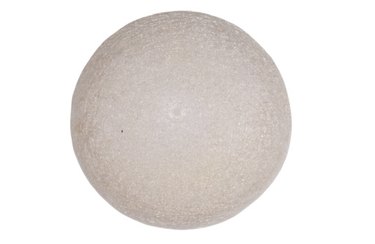Things You'll Need
Drop cloth
Foam ball, 12 inches wide
Butcher knife
Latex paint, various colors
Paintbrush
Rubber stamps

Cells are complex structures that contain a entire systems inside. These systems each carry out specific duties, whose functions effect the proper functioning of the larger structure. If you are learning about cell structure and anatomy, you can make the material more interesting and accessible by making a model of an animal cell tat you can study. You can make an animal cell model using basic materials that can be purchased from a craft supply store.
Step 1
Drape a drop cloth over the area you will be working to protect the surfaces from paint spills.
Video of the Day
Step 2
Place a large, 12-inch foam sphere onto the drop cloth. Selecting a large foam sphere, as opposed to a smaller sphere, will allow you to add more detailing onto the animal cell.
Step 3
Slice the sphere in half using a butcher knife.
Step 4
Paint the outside of both sphere halves using orange latex paint. This will represent the animal cell membrane. Let the latex paint dry for 10 minutes.
Step 5
Paint the inside of both sphere halves using pink latex paint. This will be the animal cell's cytoplasm. Let the paint dry for 10 minutes.
Step 6
Stamp three to four green rods inside both halves using a cylindrical rubber stamp and green paint to represent the animal cell's ribosomes. Let the paint dry for 10 minutes.
Step 7
Stamp four to five blue spirals inside both halves using blue paint and spiral-shaped rubber stamps to represent the animal cell's golgi bodies. Let the paint dry for 10 minutes.
Step 8
Stamp a 3-inch circle in the center of both halves using a circle rubber stamp and purple latex paint. This will be the nucleus. Stamp a smaller, 1-inch circle using orange paint in the middle of the nucleus to represent the animal cell's nucleolus. Let the paint dry for 10 minutes.
Step 9
Paint a red trapezoid on the inside of both halves to represent the cell's vacuole. Let the paint dry for 10 minutes before displaying the 3D animal cell model.
Video of the Day